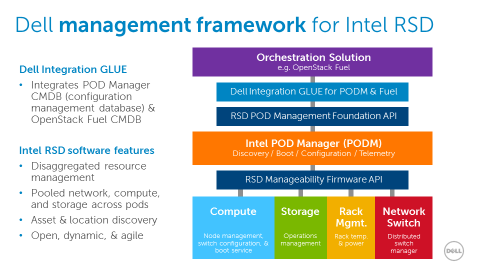In talking with our customers over the past several years, it’s clear that CIOs and IT directors are looking to maximize the value they get from their data center operations in the age of the cloud. Whether they are service providers to others or are hosting their own operations, every one of our customers is consistently looking to implement solutions more quickly and efficiently than ever before.
The continued growth of edge computing and the Internet of Things (IoT) along with the rollout of next-generation 5G networks is also driving demand among service providers for more agile, dynamically-assigned infrastructure that reduces deployment complexity and minimizes time to value for their business.
To that end, Dell has been working closely with Intel to bring such future-ready infrastructure to life as part of the Intel Rack Scale Design (RSD) program*. This software-defined architecture is purpose-built for telecommunications and cloud service providers and draws on nearly a decade of experience with the largest hyperscale IT implementations in the world. Intel RSD enables shared pools of compute and storage across one or more racks (called a pod), all connected via a flexible network fabric and a unified management system built on open standards including DMTF’s Redfish as the API’s foundation.
Though I’ve talked before about the DSS 9000 rack-scale infrastructure which underlies Dell’s approach to Intel RSD, what’s often overlooked in the solution is the systems management capabilities, which are critical components for minimizing deployment time and providing differentiated business value.
The management framework in Intel RSD is based on Intel POD Manager (PODM), which links a vendor-agnostic orchestration API and an open hardware management API together to provide control of compute, storage and network resource pools in a flexible, agile architecture. This allows service providers to implement truly software-defined data centers with solutions across Microsoft, VMware, and OpenStack clouds on the same underlying infrastructure, tuned to the dynamic needs of their customer workloads.
At this year’s Intel Developer Forum in San Francisco, Dell ESI will be showcasing the rapid deployment and robust infrastructure capabilities of our Intel RSD implementation. We’ll demonstrate how quickly deploying an OpenStack cluster with a Dell DSS 9000 using Intel POD Manager and OpenStack Fuel will revolutionize how you think about implementing cloud solutions at scale.
Imagine allocating shared pools of compute, storage, and networking across workloads as you need them, with the optimal ratio of compute or storage ideal for that application across the cloud environment of your choice and all in an open ecosystem devoid of the lock-in typical of other ‘composable’ systems rolled out by our competitors.
Open systems drive innovation for our customers and we’re also excited to announce today that the DSS 9000 rack scale solution has been recognized by the Open Compute Project (OCP) Foundation as OCP-INSPIRED. In fact, the Open Compute Project and Intel Rack Scale Design are highly complementary. Intel RSD defines a logical architecture for resource management while OCP defines a physical infrastructure implementation. The Dell DSS 9000 is the embodiment of the two working in concert together for the benefit of our customers and we’re very excited about the possibilities this brings to deliver increased agility, cost-performance, and management flexibility for service providers and scale-out organizations.
In an era where time to value is ever-present, Dell and Intel are working to bring the future of the software-defined data center to you and we look forward to showing you more of our combined innovation at this year’s Intel Developer Forum on August 16th.
*Previously known as Intel Rack Scale Architecture (RSA).


